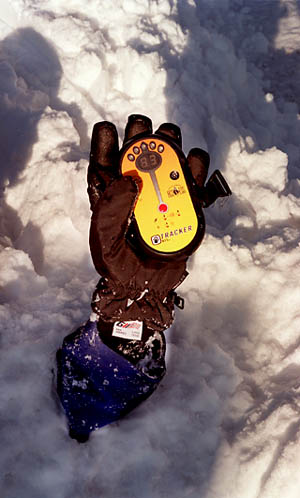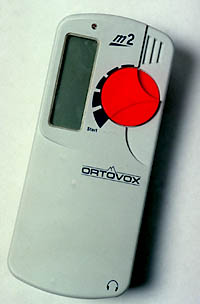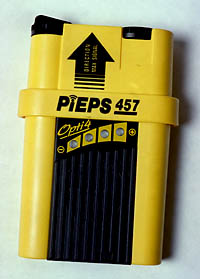Trapped
Getting to an
avalanche victim is no joke; you gotta
know your
stuff
By Miles Blumhardt
The
Coloradoan
Photos by Rich Abrahamson
When
avalanche beacons first became available
 |
DTS
TRACKER
n World's first digital beacon.
nOnly transceiver available with a dual
receiving antenna.
nHas proven
to be the most effective transceiver in the hands of novice
beacon users due to its digital distance and directional
displays.
nComes closest to
directly taking rescuers to the victim.
nNot as good at locating multiple
burials as some other brands.
nIs not as easy to put in search mode as
other models.
nCost
$300. | to average recreationists, they
were deemed the best thing since the probe
pole.
The excitement was akin to yet
another new cancer drug coming on the market. They were supposed to
dramatically reduce the 28Americans killed each year by avalanches.
But like a lot of those cancer drugs, transceivers have been long on
potential but short on results.
Despite
dramatic improvements in beacons the past few years, the sobering
news is you still stand a better chance (42 percent) being found
alive with people spot probing with poles, a method based more on
luck than skill, than with recreationists using transceivers (32
percent).
How can luck win out over
technology?
It's illogical. Or is
it?
The No. 1 factor in avalanche
survival is the time it takes to find the victim. One would believe
transceivers to be much faster in helping rescuers pinpoint the
victim than random probing. They would be if the users knew how to
efficiently use the
devices.
Professionals using transceivers
find victims alive 58 percent of the time, or nearly twice as often
as recreationists. This would seem to indicate the answer lies not
so much with the transceivers but the inefficiency of the average
recreationist using the device.
Consider
that 90 percent of buried victims found within 15 minutes survive.
Studies in the United States and Europe show transceiver users are
lethally slow, averaging more than 30 minutes to find and uncover
victims. The result was two-thirds of the victims died.
 |
ORTOVOX
M2
nHas one of the longest effective ranges at 80 meters,
which may or may not help searching.
nNext to Tracker in ease of
use.
nAlthough not as quick as
Tracker in primary search time it's Tracker's equal in
secondary search time.
nSignificantly easier to put in search
mode than Tracker.
nFaster than
Tracker at multiple searches
nIncludes a socket for
earphones.
nCost:
$300. | "I'd
bet the number of people who buy beacons and never look at the
manual or take a course is pretty high,'' said Lenny Enloe, who
manages Fort Collins Outdoor World. "The manuals that come with the
beacons are OK for general information but you need to go to a
workshop.
"It's like a GPS unit. Most
don't even bother trying to figure them out until the day before
they're going out, if even then. And just think, knowing how to use
one could mean the difference between life and
death.''
You'd think those potentially
dire consequences plus the fact they shelled out $300 for the units
would add up to learning how to properly use the beacons. But one of
the problems concerning the use of transceivers is that the products
were marketed to be as simple to use as point-and-shoot cameras.
However, the unread fine print states
otherwise.
Take for instance the
introduction in 1998 of the DTS Tracker by Boulder-based Backcountry
Access.
True, the Tracker came far closer
than any transceiver before at making avalanche rescue a
point-and-shoot affair. But the relative ease with which the average
recreationist was supposedly able to find buried victims manifested
a false sense of security. The result has been recreationists buying
transceivers but not becoming proficient enough to use them in a
manner with enough expediency to save
lives.
"When you are in an emergency
situation, you don't have time to read the directions,'' said Nick
Logan, a forecaster for the Colorado Avalanche Information Center.
"Your adrenaline is pumping because your buddy is buried and you
have to react instinctively. To save them, you have to act
fast.''
While practice is one key to
transceivers living up to their potential, Dale Atkins of the
Colorado Avalanche Information Center believes the other is to
encourage transceiver manufacturers to make the devices more user
friendly. Manufacturers have responded the past couple of years by
incorporating easy-to-read digital readouts that indicate direction
and distance to the victim.
However,
unlike what it says on the box, it's not a matter of simply pointing
the unit and following a straight line to the victim. The devices
lead rescuers to the victim via a flux or induction line. The flux
line is not a direct route to the victim but an arcing line that
with practice leads rescuers to the victim in far less time than
older transceivers. These units also eliminate the time consuming
stop-and-go process of traditional gird or tangent searching, which
few recreationists every understood.
 |
PIEPS Opti
457
n Easy to use and relatively comfortable
nIndicator light flashes when less than
50 hours left on batteries.
nSwitching to search mode is
easy.
nSocket for
earphones.
nOptical multiple
search display.
nDifficulty
changing back to transmit mode.
nVolume settings difficult to see,
especially when searching.
nDoes not have as user friendly visual
display of direction and distance to victim.
nCost:
$240. |
"It
takes a lot of practice with avalanche beacons to become competent
and quick in a search," Atkins wrote in a beacon review. "Since
transceivers are not easy to use, people do not enjoy practicing.
Frankly, skiers would rather spend time skiing than practicing
beacon searches."
Although different
studies have sent mixed signals as to which transceivers are the
best, many professionals and recreationists regard the Tracker as
the most user-friendly unit on the market. An indication of how much
faster the Tracker is at finding a victim compared to other units
was the fact the Tracker was not allowed at the 1999 Colorado
Professional Ski Patrol Convention "because it created an unfair
advantage." However, at the end of the competition, the Tracker was
used to compare times and it easily beat the day's best time using
other transceivers.
Since the Tracker
came on the market, other manufacturers have caught up with its
user-friendly digitally displayed directional arrows and distance
indicators. Though they derive the information differently, the
German-made Ortovox M2 and French-made ARVA 9000 both have
incorporated visual directional and distance
displays.
"My experience is that with a
Tracker I can give it to people who have never used a transceiver,
show them the fundamentals and they can find a buried beacon,'' said
Logan, who uses a Tracker. "They might not be really quick the first
time but it's more intuitive than with some other
beacons.''
At one time, it was believed
that high-frequency transceivers would increase the success of
rescues due to the units' longer range. But a number of tests have
shown that longer-ranged transceivers do not necessarily lead to
quicker rescues for all.
In 1999,
Ski magazine had 95 people unacquainted with avalanche
transceivers test them for ease of use. One of the more striking
results was at least in the hands of novices, transceivers with
shorter reception range - the Tracker and ARVA 9000 - were
significantly faster than longer-reception transceivers such as the
Ortovox M1 and Ortovox Classic.
What
wasn't clear was why. Was it because of search patterns or the
sensitivity of the digital beacons?
"Long
ranges help rescue teams search large areas more quickly, but for
recreational users, long range units can even prolong the search,"
Atkins wrote. "In the United States, the increased range has not
improved search times or saved more lives. Practice and proficiency
are significantly more important than
range."
But whether you choose the DTS
Tracker, Ortovox M2, ARVA 9000, PIEPS or any other model, Atkins
said there is one signal to be heard loud and clear: "practicing and
choosing your friends wisely are the best ways to improve the
chances of survival."
Here are some tips on using and
practicing with avalanche transceivers:
nNever use rechargeable batteries! They
seem fine, then drop off abruptly.
nChange your batteries before they
discharge too low-use them in your headlamp for the rest of
their life.
nWear your beacon
against your body, under your outer layers. Don't carry it in
your pack or pocket where it can be torn away from your
body.
nMake practicing with
your unit fun by making up games. Bet your buddy a beer you
can find the transceiver he/she hides faster than they can
find the transceiver you hide. Don't drink the beer til you
get home.
nWhen you practice,
hide the transceiver in different positions, such as lying
flat or standing up, at varying distances and at different
depths. The reason being these situations require slightly
different skills to locate the transceiver.
nCan't get away to practice your skills,
then practice finding the beacons at home or, don't let the
boss find out, at the office. Lenny Enloe, manager of Fort
Collins Outdoor World, said his employees would hide them
around the store.
nUsing
beacons isn't like screwing in a light bulb, you need to read
the manual. But because the manual doesn't cover it all, take
a class. The Colorado Avalanche Information Center can help
with class information. Contact the center at
www.caic.state.us, by fax at (303) 499-9618 or by phone at
(303) 499-9650.
nBeacons don't
do much good unless you also have a shovel and probe
pole.
nDale Atkins of the
Colorado Avalanche Information Center has produced a video:
Avalanche Rescue Beacons: A Race Against Time. Using live
action and computer animation, this program teaches viewers
how to use avalanche beacons, basic search techniques and how
to search for someone who is not wearing a beacon. Cost is $25
and the video can be ordered by calling 303-
866-2611.
Want more help? Check out these
Web sites:
nhttp://www.caic.state.co.us/
nhttp://www.avalanche.org/
nhttp://www.csac.org/
nwww.gearreview.com | |
|